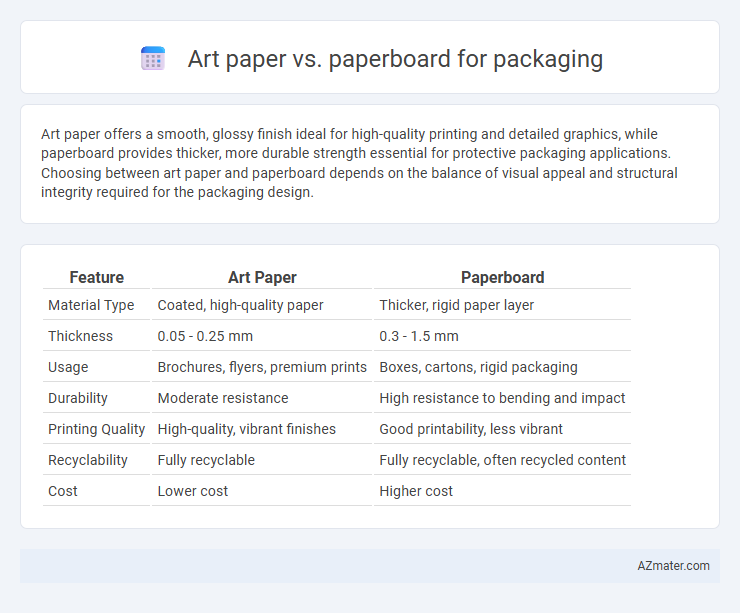Art paper offers a smooth, glossy finish ideal for high-quality printing and detailed graphics, while paperboard provides thicker, more durable strength essential for protective packaging applications. Choosing between art paper and paperboard depends on the balance of visual appeal and structural integrity required for the packaging design.
Table of Comparison
| Feature | Art Paper | Paperboard |
|---|---|---|
| Material Type | Coated, high-quality paper | Thicker, rigid paper layer |
| Thickness | 0.05 - 0.25 mm | 0.3 - 1.5 mm |
| Usage | Brochures, flyers, premium prints | Boxes, cartons, rigid packaging |
| Durability | Moderate resistance | High resistance to bending and impact |
| Printing Quality | High-quality, vibrant finishes | Good printability, less vibrant |
| Recyclability | Fully recyclable | Fully recyclable, often recycled content |
| Cost | Lower cost | Higher cost |
Introduction to Packaging Materials
Art paper features a smooth, coated surface ideal for high-quality printing and visual appeal, making it suitable for luxury packaging applications. Paperboard, thicker and more rigid than art paper, provides enhanced durability and structural strength essential for protecting products during shipping and handling. Both materials serve distinct roles in packaging, with paperboard offering superior support, while art paper emphasizes aesthetic presentation.
Defining Art Paper and Paperboard
Art paper is a high-quality, coated paper known for its smooth surface and excellent printability, commonly used in premium packaging to enhance graphics and color vibrancy. Paperboard is a thicker, more rigid material comprising multiple layers of paper fibers, designed for structural support and protection in packaging applications like boxes and cartons. Both materials serve distinct roles in packaging, with art paper prioritizing visual appeal and paperboard emphasizing durability and strength.
Material Composition and Characteristics
Art paper features a smooth, coated surface made primarily from wood pulp combined with clay and other fillers, offering high whiteness and excellent print quality ideal for detailed graphics. Paperboard, thicker and more rigid, consists of multiple layers of pulped fibers, providing enhanced durability, stiffness, and cushioning properties suitable for protective packaging. The superior tensile strength and moisture resistance of paperboard make it preferable for heavy-duty packaging, while art paper excels in visual appeal and printability for product presentation.
Print Quality and Visual Appeal
Art paper offers superior print quality with its smooth, coated surface that enhances color vibrancy and sharpness, making it ideal for high-resolution images and detailed graphics. Paperboard, while thicker and more durable, often has a rougher texture that can slightly diminish print clarity but provides excellent structural strength for packaging. Choosing art paper elevates visual appeal with glossy or matte finishes, whereas paperboard prioritizes functionality with a sturdier feel and can be finished for aesthetic effects without compromising durability.
Durability and Protection
Art paper and paperboard differ significantly in durability and protection for packaging applications. Paperboard offers superior thickness and rigidity, providing enhanced cushioning and resistance to damage during shipping and handling. Art paper, while visually appealing with a smooth surface and vibrant print quality, lacks the structural strength needed to protect heavier or fragile items effectively.
Eco-Friendliness and Sustainability
Art paper and paperboard differ significantly in eco-friendliness and sustainability, with paperboard generally offering a higher environmental benefit due to its thicker structure and greater recyclability. Paperboard often uses recycled fibers and requires less energy to produce per unit of packaging volume, reducing its overall carbon footprint compared to art paper, which is typically coated and less biodegradable. Choosing paperboard for packaging supports sustainability goals by promoting resource efficiency and reducing waste in the packaging lifecycle.
Cost Considerations
Art paper generally offers a lower cost advantage for lightweight packaging applications due to its thinner profile and simpler manufacturing process, making it ideal for products where aesthetics and budget are prioritized. Paperboard, with its thicker and more durable structure, incurs higher material and production costs but provides enhanced protection and rigidity, justifying the expense for heavier or fragile items. Selecting between art paper and paperboard hinges on balancing packaging requirements against budget constraints, considering factors like product weight, transportation conditions, and desired shelf appeal.
Common Packaging Applications
Art paper is frequently used for high-quality printed packaging like luxury boxes, gift wraps, and cosmetic packaging due to its smooth surface and excellent printability. Paperboard offers superior strength and durability, making it ideal for structural packaging such as cereal boxes, beverage carriers, and folding cartons. The choice between art paper and paperboard in packaging depends largely on the product's protection needs and visual presentation requirements.
Customization and Finishing Options
Art paper offers exceptional surface smoothness and brightness, making it ideal for high-quality printing with vibrant colors and detailed graphics, suitable for premium packaging. Paperboard provides superior thickness and rigidity, allowing for diverse customization such as embossing, debossing, foil stamping, and spot UV coating, enhancing tactile appeal and structural strength. Both materials support various finishing techniques, but paperboard's versatility in customization makes it preferred for durable, visually striking packaging solutions.
Choosing the Right Material for Your Packaging
Art paper offers a smooth, glossy finish ideal for high-quality color printing and premium packaging aesthetics, while paperboard provides thicker, sturdier protection suited for heavy or bulky products. Selecting the right packaging material depends on product weight, desired durability, and visual appeal; art paper enhances branding with vibrant graphics, whereas paperboard ensures structural integrity during shipping and handling. Understanding these material properties helps businesses optimize both presentation and functionality for their packaging needs.

Infographic: Art paper vs Paperboard for Packaging
 azmater.com
azmater.com